Cooper’s Hawk vs Sharp-Shinned Hawk – they look nearly identical, so how to identify one or the other?
Identifying Cooper’s Hawks and Sharp-shinned Hawks can be a major challenge. These Accipiters look very similar, and some are left unidentified.
On this page
Body & Shape
Both of these hawk species have body shapes adapted for catching birds in wooded habitats. To help them maneuver between trees and bushes, they have tubular bodies with rounded wings and long tails. They also have long legs with needle-sharp talons and have sharp beaks for tearing flesh.
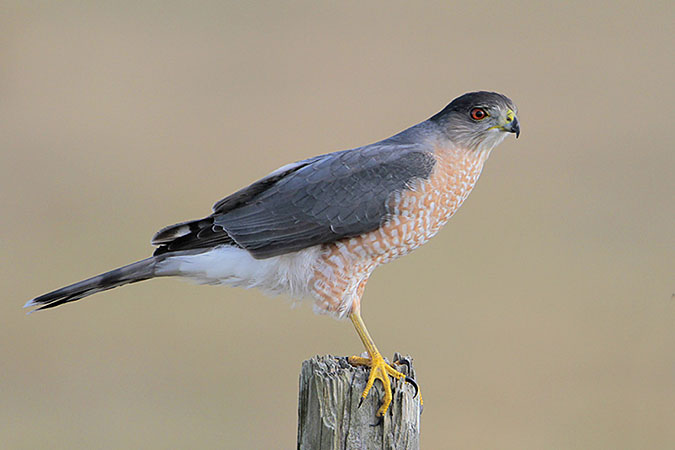
The Cooper’s Hawk has a tail with a rounded tip while the tail of the Sharp-shinned Hawk is more rectangular. The wings of both hawk species are similar but, in flight, Cooper’s Hawks have a straighter leading edge. When held open, Sharp-shinned Hawk wings are held slightly bent.
However, most can be separated by size, and the shape of the tail. Cooper’s Hawks are bigger, heftier birds with a long, rounded tail. The dainty Sharp-shinned Hawk, on the other hand, is the size of a dove or jay, and has a square-tipped tail.
Adults of both species have blue-gray upperparts, and underparts with burnt-orange barring.
The square-shaped head of the Cooper’s Hawk tends to have a dark cap compared to the smallish, rounded head of the Sharp-shinned Hawk.
The Cooper’s Hawk also has a “blocky” head, while the Sharp-shinned Hawk has a smaller, rounded head. On perched birds, we can also see that Cooper’s Hawks have thicker legs, and Sharp-shinned Hawks have skinnier, “stick-like” legs.
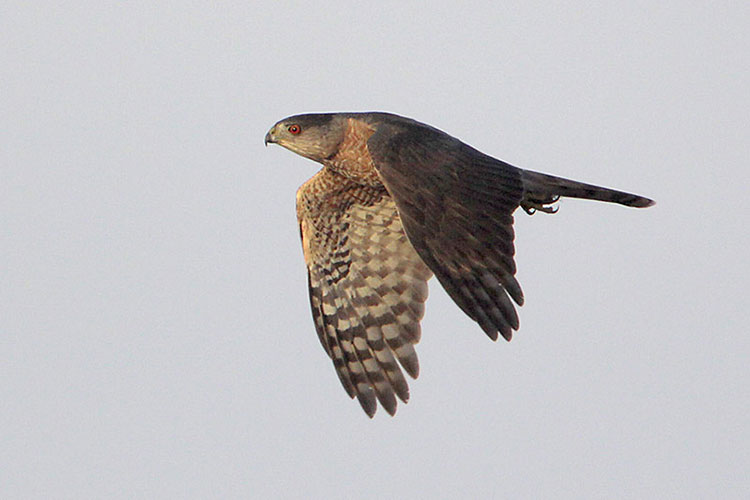
Sharp-shinned Hawk
Juvenile Cooper’s Hawks and young Sharp-shinned Hawks also look very similar. They are brown above and pale below with dark brown streaks, but can be told apart by the shape of the tail, wings, and head.
Young Cooper’s Hawks also tend to have a more uniform buff-colored head and underparts with narrower streaks. Juvenile Sharp-shinned Hawks often have a head with more patterned, pale markings, and thicker streaks on the breast and belly.
Cooper’s Hawk vs Sharp-Shinned Hawk Size
It can be tough to tell how truly big or small a bird is, but comparisons with other birds can help. In the case of Cooper’s and Sharp-shinned Hawks, the Cooper’s is around the same size as an American Crow. It looks robust or heavy-bodied, and, in flight, it has deeper wing beats.
The Sharp-shinned is truly small. Around the same size as an American Robin or a Blue Jay, it doesn’t look nearly as strong as a Cooper’s Hawk, and has quick and snappy wing beats.
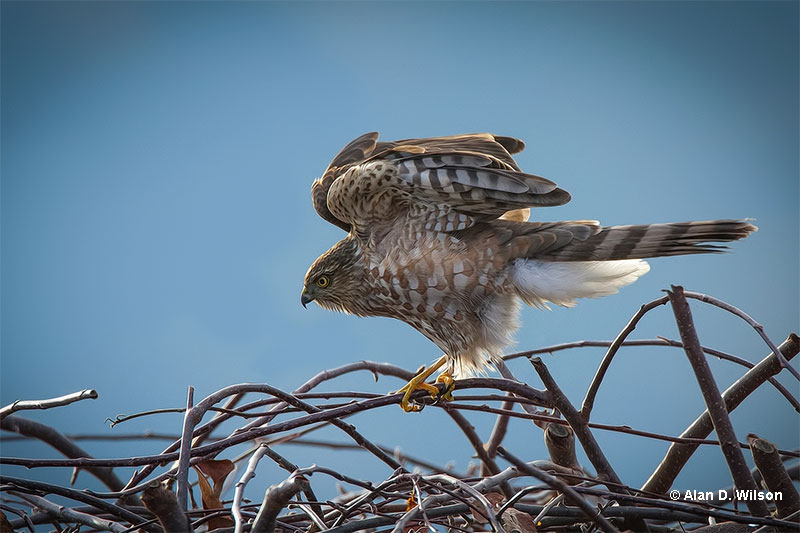
Sharp-shinned Hawks are much smaller in size
Cooper’s Hawks are hefty and powerful hawks that are larger and heavier than Sharp-shinned Hawks. The biggest female Cooper’s Hawks can be 17 inches long. This species also has a 35-inch wingspan and can weigh more than 600 grams (about two pounds). Small male Cooper’s Hawks are 15 inches long and weigh 330 grams.
These measurements are substantially larger than the 12 to 14-inch length of the female Sharp-shinned Hawk. Female Sharp-shinned Hawks weigh 150 to 219 grams, while the smaller male Sharp-shinned Hawk weighs in at 82 to 115 grams. Males are only nine to twelve inches long, and their wingspan is just 17 to 22 inches.
Speed
Cooper’s Hawks and Sharp-shinned Hawks are quick on the wing, especially when chasing prey. Both species can reach speeds of 50 mph, and Sharp-shinned Hawk have been clocked at 60 mph!
Top speeds for both species are probably reached in open areas. However, they can still fly surprisingly fast in dense habitats, especially the Sharp-shinned Hawk. When chasing prey, this bird moves as fast as it can, even while dodging tree trunks and branches.
Both species have a characteristic flight style typical of the Accipiter species. They fly with a few quick flaps followed by a glide, and then quickly flapping again.
Cooper’s Hawks have straighter wings with deep, rowing flaps, while Sharp-shinned Hawks have rapid and snappy wing beats. This small hawk also soars with slightly bent wings.
Cooper’s Hawk vs Sharp-Shinned Hawk Age
Cooper’s Hawks live ten to fifteen years in the wild but can live for 25 years in captivity. If this strong raptor can survive for more than two years after hatching, it has a good chance of living a full, regular lifespan. Few predators dare to attack adult Cooper’s Hawks but nestlings are much more vulnerable.
Although adults do what they can to protect nests, young birds can be taken by Raccoons and Great Horned Owls. On occasion, these big and powerful owls also catch roosting adults.
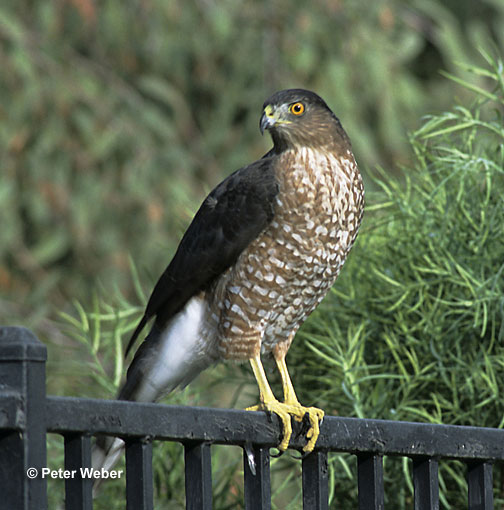
Cooper’s Hawk
Another source of mortality among Cooper’s Hawks is other Cooper’s Hawks! It doesn’t happen that often but once in a while, big female Cooper’s Hawks kill smaller males in fights over territory.
The Sharp-shinned Hawk can survive for 10 or even 20 years, but most don’t live longer than five or six years. Like the Cooper’s Hawk, when nesting, this small raptor is vulnerable. At night, roosting birds and nestlings can be attacked by Great Horned Owls and other owl species. Raccoons and other arboreal mammals can also attack them.
When they chase birds in low vegetation, Sharp-shinned Hawks are susceptible to being hit by cars. During migration, some also die after flying into windows, being illegally shot by people, and being caught by Peregrine Falcons and other raptors.
Behavior
Sharp-shinned and Cooper’s Hawks spend a lot of time stalking birds and small mammals. They move through their territories by flying to a perch, watching for prey, and then carefully moving to the next spot. They hope to catch prey by surprise in and near wooded areas.
During spring, both of these raptors make loud, staccato calls. The Cooper’s Hawk makes a series of kek-kek-kek calls reminiscent of a laughing, barking woodpecker.
The Sharp-shinned Hawk makes a much higher-pitched series of pew-pew-pew calls that sound like a falcon.
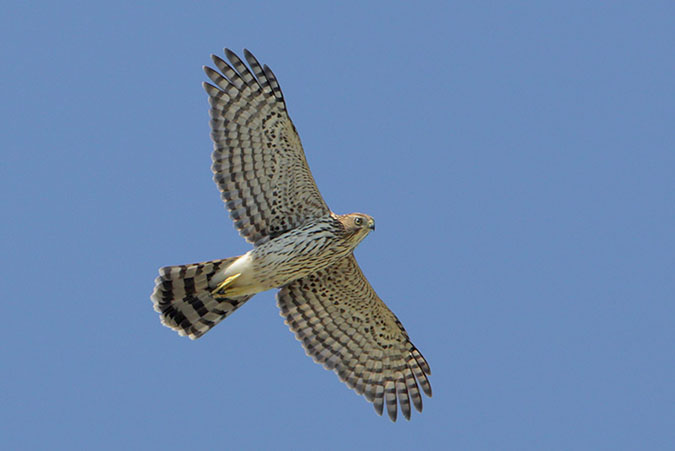
Cooper’s Hawks and Sharp-shinned Hawks also soar. They may fly above their territories to defend it, and also frequently soar during migration.
Both of these hawks are aggressive to other birds and may chase some larger bird species that they don’t catch for food.
The Sharp-shinned Hawk may do this more than the Cooper’s, sometimes, with unfortunate lethal results. When Sharp-shinned Hawks mob large and dangerous birds like the Peregrine Falcon or Bald Eagle, they can be caught, killed and eaten!
The Cooper’s Hawk is aggressive around its nest. To defend its young, in some public parks, this hawk has flown at people, pets, and other animals that ventured too close.
Its behavior gets much more aggressive with people and animals attempting to climb to the nest. As with many other raptors, it won’t hesitate to divebomb those perceived threats.
The Sharp-shinned Hawk also defends its nest but isn’t as aggressive. However, both parents will chase and attack ravens, deer, and other potential predators that come too close.
Cooper’s Hawk vs Sharp-Shinned Hawk Diet
Cooper’s Hawks are predators of squirrels, doves, jays, European Starlings, American Robins, woodpeckers, and other small and medium-sized birds.
Sharp-shinned Hawks mostly eat warblers, sparrows, and any other small birds they manage to catch. Both species stalk feeders but Cooper’s Hawks tend to eat larger birds. Sharp-shinned Hawks go after House Finches, Goldfinches, and other small species.
Related: How much weight can hawks carry?
These raptors are also important predators at bird nests. Both species attack open cup nests to catch and eat nestlings of various species.
Cooper’s Hawks and Sharp-shinned Hawks forage in a similar fashion. They wait on a hidden or semi-concealed perch near a good spot for prey, and then ambush the animal when the opportunity presents itself.
Bird feeders, farm fields, and marshes next to woods are typical, good hunting areas for Cooper’s and Sharp-shinned Hawks.
They also fly low through semi-open areas, hoping to see and catch birds and small mammals by surprise. In general, Cooper’s Hawks tend to catch animals on the ground or in low brush, and “Sharpies” catch prey in flight, and in vegetation. Both species use their long legs and talons to catch and kill their food.
Location
Cooper’s Hawks are adaptable raptors that live in forest and partly wooded areas. As long as enough trees are present, they also thrive in cities and other urban environments. They especially like deciduous forest, mixed deciduous woodlands, and riparian zones.
These big hawks are seen in southern Canada and in much of the USA. In winter, some also migrate to Mexico and Central America.
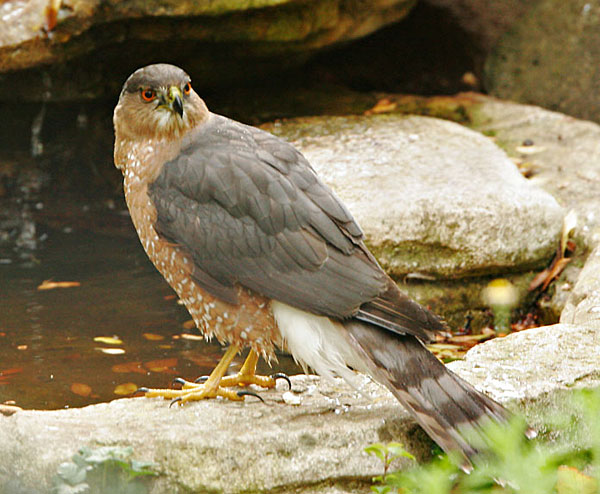
Cooper’s Hawks can be spotted in more open areas
Unlike the Cooper’s Hawk, Sharp-shinned Hawks only breed in heavily forested areas. This small hawk prefers to nest in boreal forest and other coniferous woodlands but also lives in mixed deciduous/coniferous forest.
They spend the summer in Alaska, much of Canada, the Rocky Mountains, the Pacific Northwest, and the eastern USA south to northern Georgia. Other populations breed in the Caribbean, in montane forests from Mexico to Nicaragua, and parts of South America. This species winters in much of the USA, Mexico, and parts of Central America.
During the winter months, both species frequent wooded and semi-open habitats. Many also stalk bird feeders, grain silos, and other situations with abundant prey.
Nest & Eggs
The Cooper’s Hawk lays 4 pale blue eggs in a large, bulky nest made of sticks. The eggs weigh 43 grams each and the nest is two feet in diameter and 7 inches deep. This species often builds its nest on top of old squirrel and hawk nests, and the male does most of the nest building.
Males also help with incubation a little bit, but the female does most of it. The eggs hatch after five weeks and the young stay in the nest for nearly five weeks more. After leaving the nest, adults still defend and bring food to young birds for seven more weeks.
Learn more: Baby hawks (from hatching to leaving the nest)
The female Sharp-shinned Hawk builds a bulky nest made of dead conifer twigs, and lined with bark and green twigs. The nest is 19 inches in diameter, 5 inches deep, and placed in a dense stand of trees.
She lays four to five pale-blue eggs with some brown or violet markings. Each eggs weighs 19 grams and hatches after 30 days.
Young birds leave the nest after 21 to 32 days and continue to be fed by both parents for up to six weeks after leaving the nest.
Cooper’s Hawk vs Sharp-Shinned Hawk: Frequently Asked Questions
What is the difference between Cooper’s Hawk and Sharp-Shinned Hawk?
The Cooper’s Hawk is larger than the Sharp-shinned Hawk, has a more rounded tail, and a larger, square-shaped head.
How can you tell a Cooper’s Hawk?
A Cooper’s Hawk is a crow-sized, long-tailed hawk with blue-gray upperparts, and reddish-orange barring on the underparts. Juveniles are brown above and with fine brown streaks below.
How can you tell if a hawk is a Sharp-shinned?
Sharp-shinned Hawks are small, have long, rectangular tails, are blue-gray above, and have reddish-orange barring below. Juveniles are brown above and have heavy brown streaks on the underparts.
How to tell the difference between Coopers Hawk and Sharp-Shinned tail feathers?
The Cooper’s Hawk has rounded tail feathers with a broad white tip. The Sharp-shinned Hawk has rectangular tail feathers with less white on the tip.

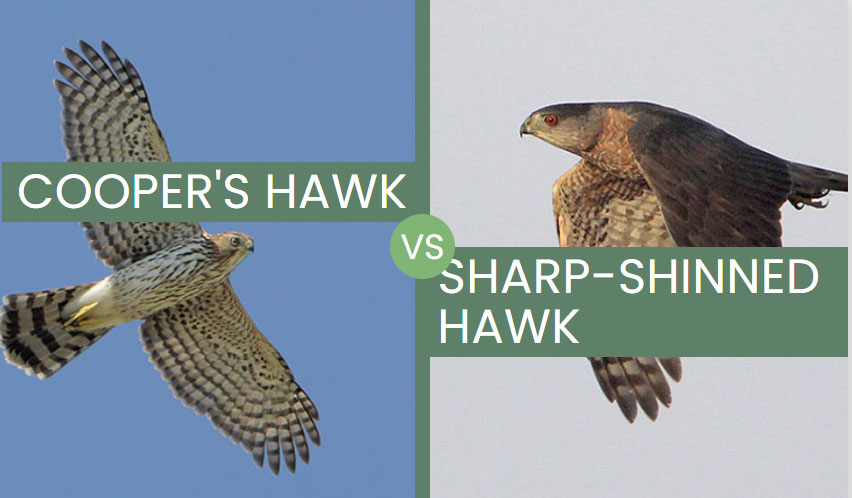

Robert (Bob) Sanders
Thursday 5th of October 2023
Well done, accurate, informative. Thanks.